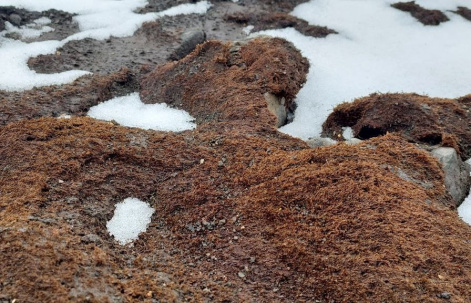Fossil mosses release methane after Antarctic glaciers melting
23 January 2024 г.

The summer of 2023 was marked by extremely high summer temperatures, and the extent of sea ice around Antarctica was the lowest on record since 1979. Local warming was also recorded on King George Island (Waterloo), located north of the Antarctic Peninsula, where the boundary of the Antarctic Bellingshausen Glacier retreated. As a result, the fossil mosses located under the ice dome began to thaw. The specialists suggest that the age of these mosses should correspond to the Little Ice Age of the Holocene.
Scientists from the Federal Research Center "KSC SB RAS", together with colleagues from Moscow and St. Petersburg, during their expedition to Antarctica, assessed the flows of greenhouse gases, in particular methane, from the surface of fossil mosses. The results show that fossil mosses release methane into the atmosphere.
Polar ecosystems are sensitive to climate change. Organic matter that melts from permafrost becomes a source of greenhouse gases. Fossil mosses, stored in glaciers for several thousand years, represent organic matter that has not yet decomposed. When they thaw, they become available to microorganisms, which immediately begin to process them, releasing methane. As a result, after the glacier retreated in Antarctica, ancient mosses became a source of methane.
“Since the ice sheet in Antarctica is quite thick, it will take a long time for it to melt and allow fossil organic life to appear on the surface. But we expect that the melting of glaciers will continue and more areas covered with fossil mosses will appear. The results have important implications for predicting greenhouse gas fluxes around receding glaciers in response to climate change. Now we have a unique opportunity to assess what will happen when the ice melts and remains of ancient plants appear on the surface. When the Antarctic ice thaws, the flow of methane into the atmosphere will increase,” said one of the authors of the study, Svetlana Evgrafova, Candidate of Biological Sciences, senior researcher at the V.N. Sukachev Institute of Forests SB RAS.
The research was supported by the Russian Science Foundation (project No. 21-17-00163).
Scientists from the P.I. Melnikov Institute of Permafrost Science SB RAS, Institute of Geography RAS, A.N. Severtsov Institute of Ecology and Evolution RAS, St. Petersburg State University, Arctic and Antarctic Research Institute and Siberian Federal University also took part in the research.
Share:
